Tuesday Mar. 4, 2008
A new Optional Assignment
was handed
out in class today. The assignment is due at the start of class
next Tuesday, Mar. 11.
The Experiment #2 reports and the revised
Expt. #1 reports were collected in class today.
The Experiment #3 materials will be
distributed this week.
How to safely
jump start a car with a dead battery.
We'll
spend at least the next two class periods on electromagnetic
radiation. It is the most important energy transport process
because it can travel through empty space.
To really understand EM radiation you need to understand
electric
fields. To understand electric fields we need to quickly review a
basic rule concerning static electricity.
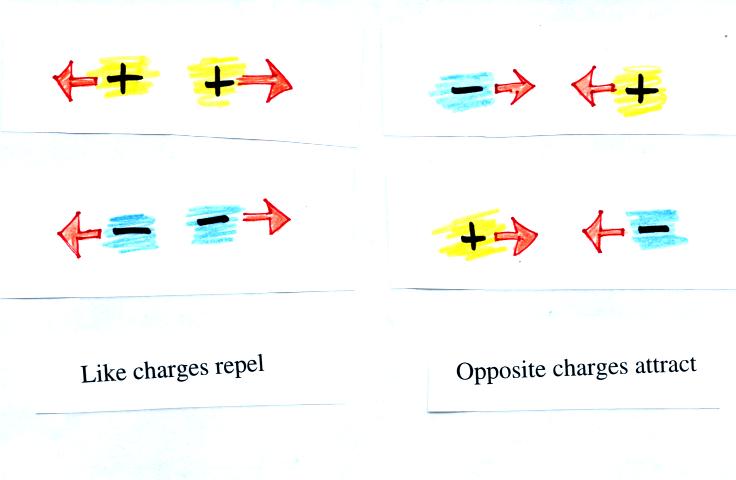
The rule is illustrated above. You'll find this summarized on p.
59 in the photocopied Classnotes.
Now imagine, as shown below, placing a + charge at three different
positions (a, b, & c) around another center charge.
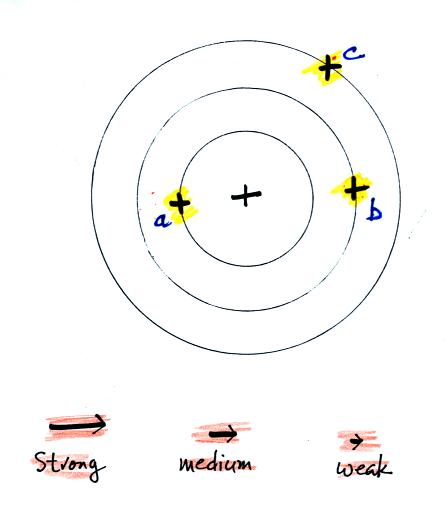
Each of the charges is going to be repelled by the center
pushed.
The charge at (a) will be pushed to the left with a fairly strong force
(because it is closest to the center charge). The charge at (c)
is further from the center and will be pushed to the upper right with a
weak force. Charge (b) will pushed to the right with medium
strength force. These various forces are shown on the next figure.
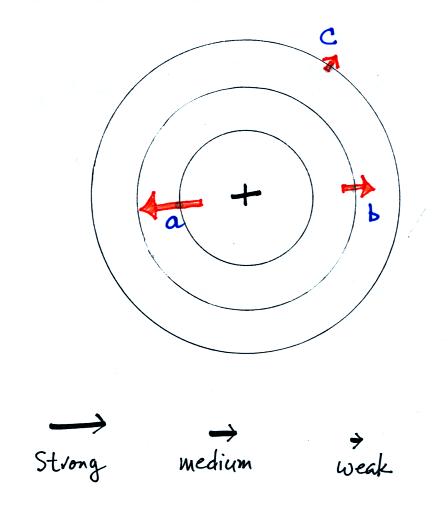
With just a little thought you can see that if you were to
place +
charges at other positions you would eventually end up with a pattern
like shown at the bottom of p. 59 in the photocopied Classnotes.
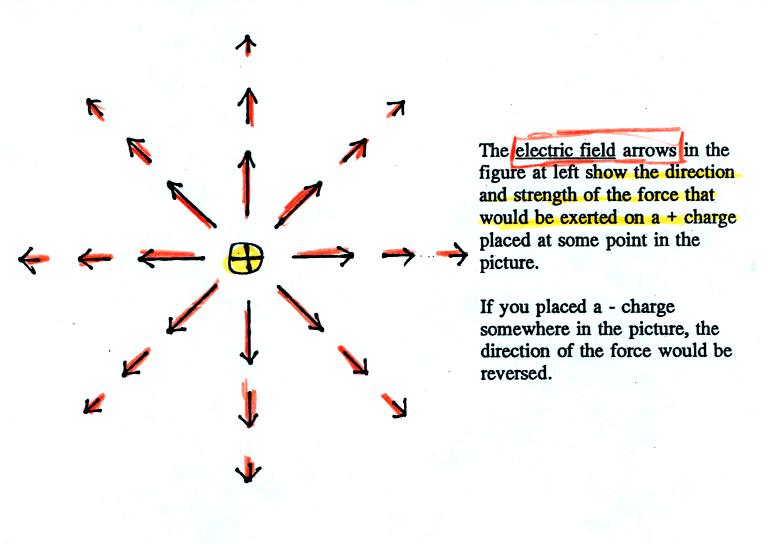
This is the pattern of the electric field vectors or arrows
around a
center + charge. The arrows tell you the direction and strength
of the force that would be exerted on a second + charge placed anywhere
is the figure. We will use these electric field arrows to
understand the behavior of electromagnetic radiation.
The figure
on p. 60 has been split into 3 pieces and redrawn
below for clarity.
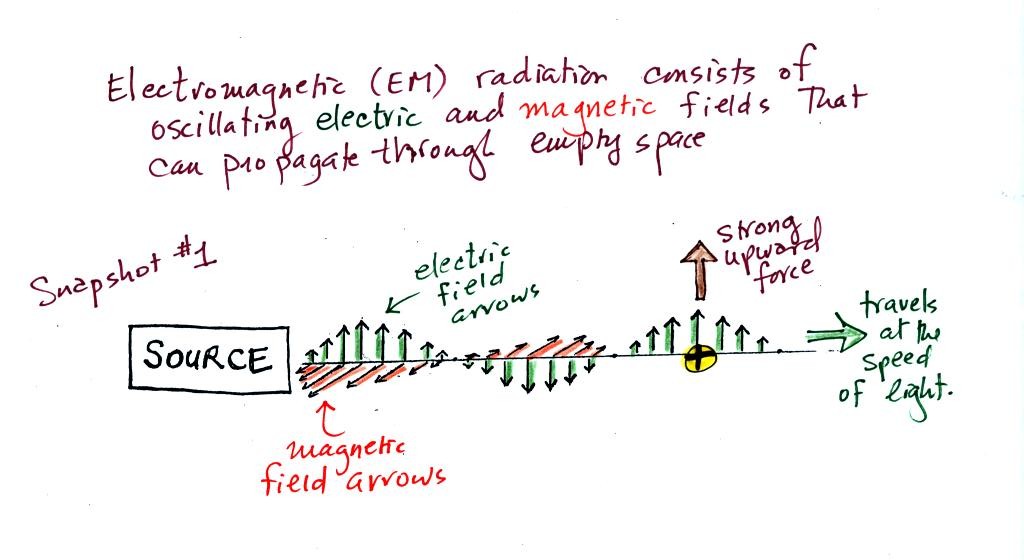
We imagine turning on a source of EM radiation and then a
short time
later we take a snapshot. During this time the EM radiation has
propagated off to the right. If you could see the radiation you
would see a wavy pattern of
electric and magnetic field arrows. We'll ignore the magnetic
field lines. The E field lines sometimes point up, sometimes
down. The pattern of electric field arrows repeats itself.
Note the + charge near the right side of the picture. At the time
this
picture was taken the electric field arrow at the position of the +
charge indicates that the radiation is exerting a strong upward force
on the charge.
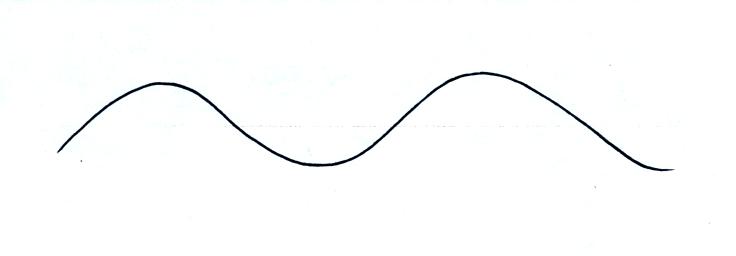
Textbooks often represent EM radiation with a wavy line like
shown
above. The first snapshot figure above shows us what this wavy
line really represents.
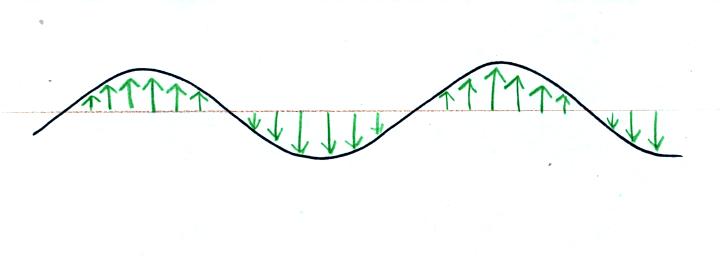
The wavy line just connects the tips of a bunch of electric
field
arrows.
Now we
take another snapshot a short time later. The wavy pattern has
moved to the right.
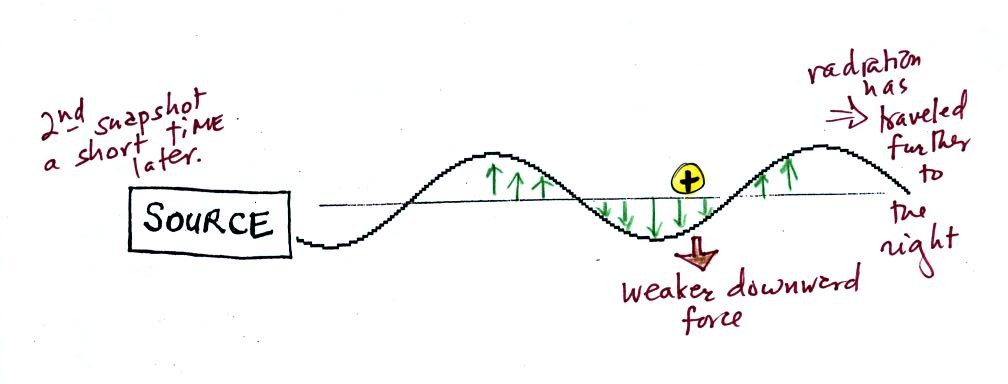
The EM radiation now
exerts a relatively weak downward force on the + charge.
And finally one more snapshot.
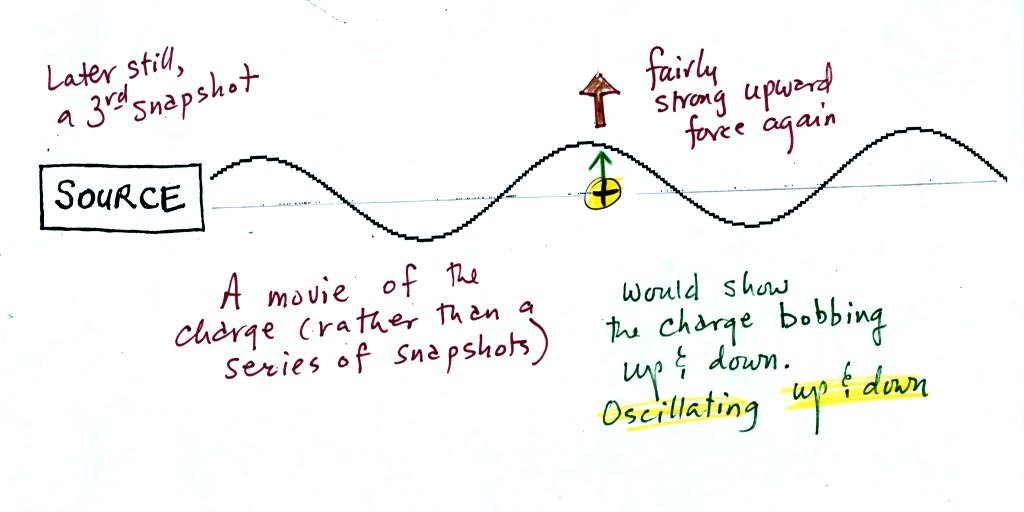
The + charge is now being pushed upward again. A movie
of
the +
charge, rather than just a series of snapshots, would show the charge
bobbing up and down much like a swimmer in the
ocean would do as waves passed by.

The wavy pattern used to
depict EM radiation can be described spatially in terms of its
wavelength,
the distance between identical points on the pattern. By
spatially we mean you look at different parts of the radiation at one
particular time.
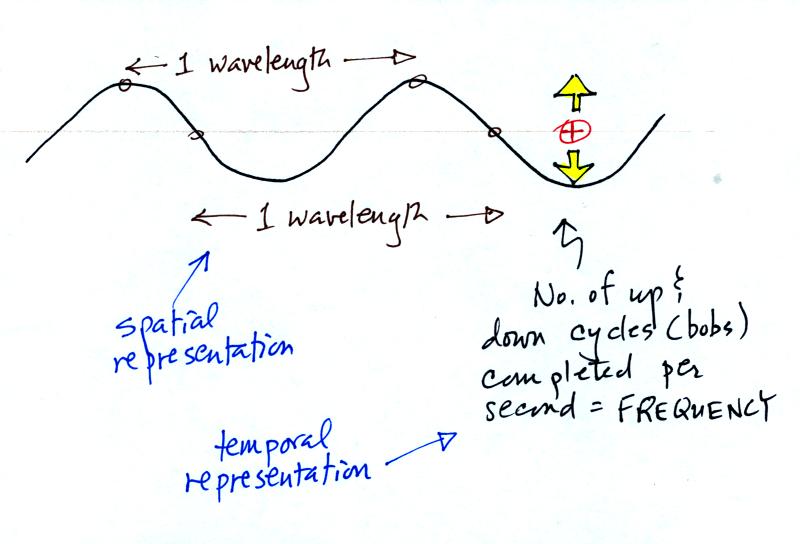
Or you can
describe the radiation temporally
using the frequency of oscillation
(number of up and down cycles completed by an oscillating charge per
second). By temporally we mean you at one particular point for a
period of time.
One way of
producing EM radiation is to move an electrical charge up and down.
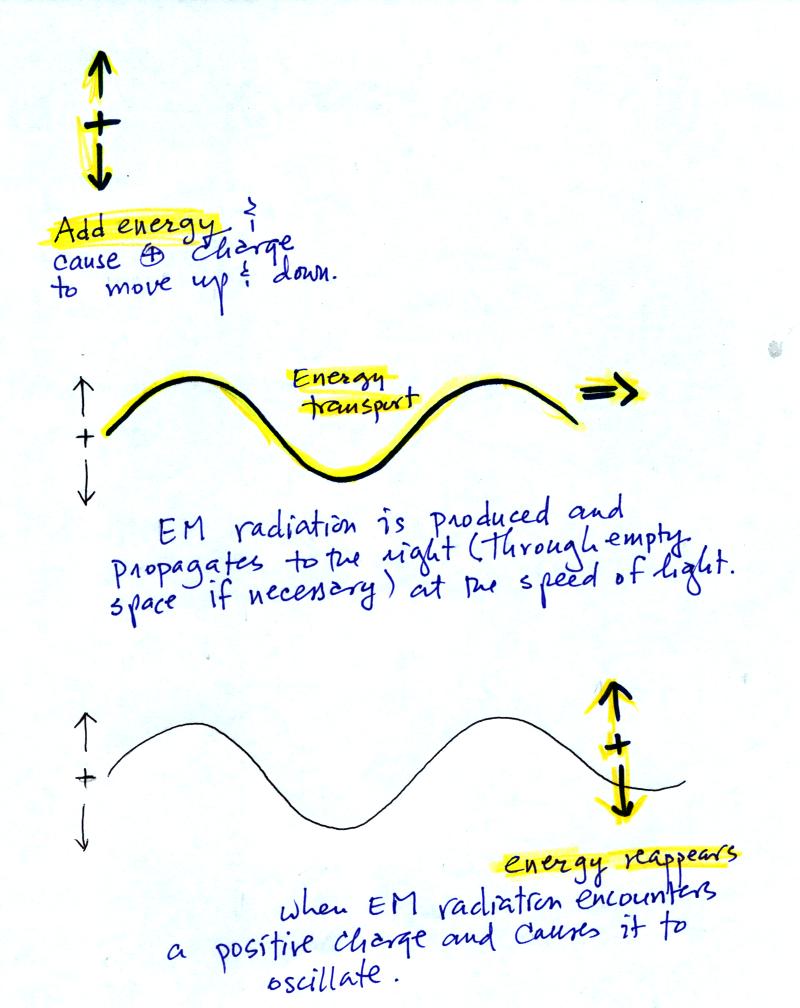
You add energy when you cause an electrical charge to move up and down
and create the EM radiation (top).
In the middle figure, the EM
radiation then travels out
to the
right (it could be through empty space or through something like the
atmosphere).
Once
the EM radiation encounters an electrical charge at another location
(bottom right),
the energy reappears as the radiation causes the charge to move.
Energy
has been transported from left to right.
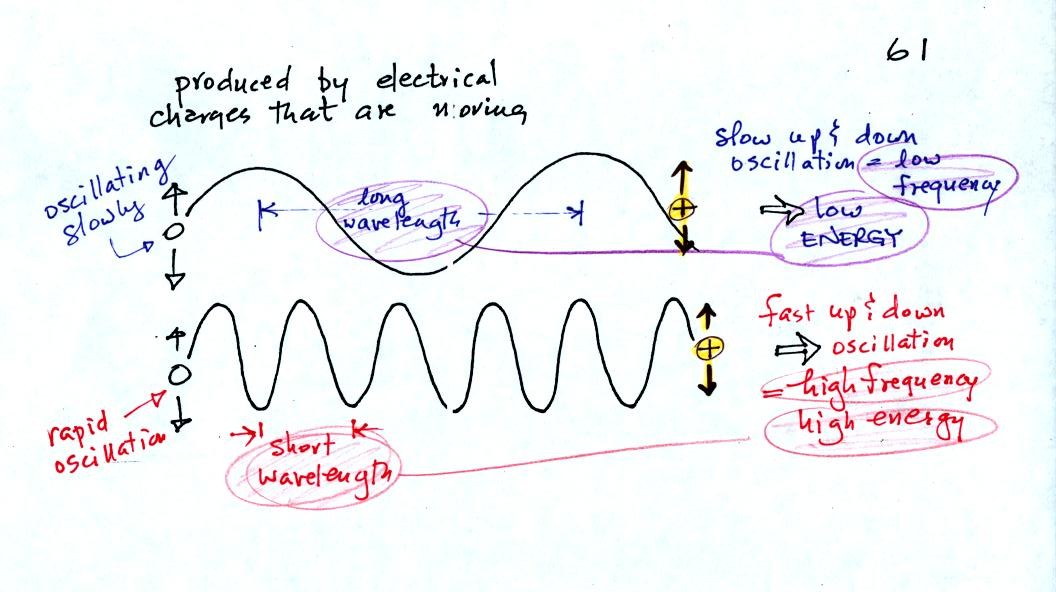 EM radiation is created
when you cause a charge to move up and down.
If you move a charge up and down slowly (upper left in the
figure above) you would produce long wavelength radiation that would
propagate out to the right at the speed of light. If you move the
charge up and down more rapidly you produce short wavelength radiation
that propagates at the same speed.
EM radiation is created
when you cause a charge to move up and down.
If you move a charge up and down slowly (upper left in the
figure above) you would produce long wavelength radiation that would
propagate out to the right at the speed of light. If you move the
charge up and down more rapidly you produce short wavelength radiation
that propagates at the same speed.
Once the EM radiation encounters the charges at the right side of the
figure above the EM radiation causes those charges to oscillate up and
down. In the case of the long wavelength radiation the charge at
right oscillates slowly. This is low frequency and low energy
motion. The short wavelength causes the charge at right to
oscillate more rapidly - high frequency and high energy.
The characteristics long wavelength - low frequency - low energy go
together. So do short wavelength - high frequency - high energy.
Note that the two different types of radiation both propagate at the
same speed.
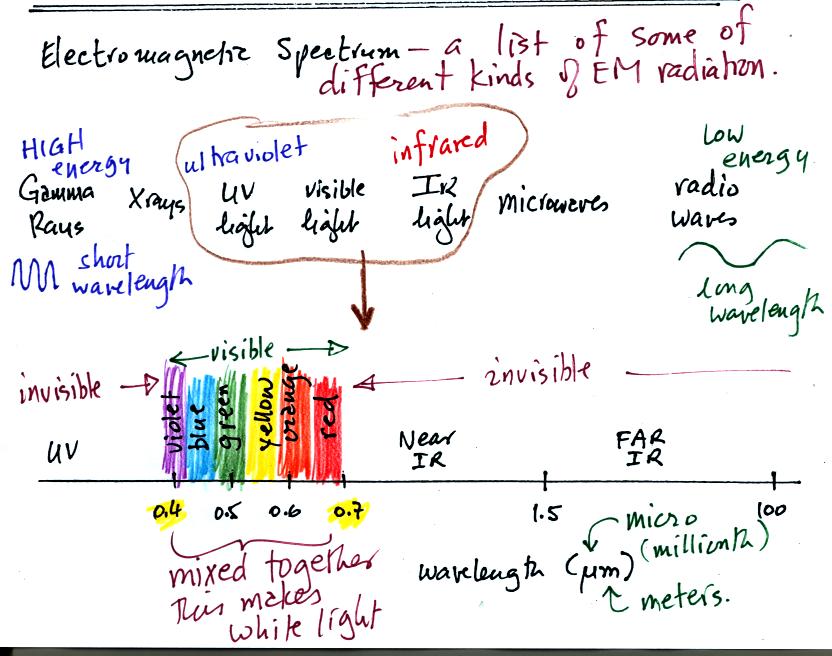
This is really just a partial list of some of the different
types of EM
radiation. In the top list, shortwave length and high energy
forms of EM radiation are on the left (gamma rays and X-rays for
example). Microwaves and radiowaves are longer wavelength, lower
energy forms of EM radiation.
We will mostly be concerned with just ultraviolet light (UV), visible
light (VIS), and infrared light (IR). Note the micrometer
(millionths of a meter) units used for wavelength. The visible
portion of the spectrum falls between 0.4 and 0.7 micrometers (UV and
IR light are both invisible). All of the vivid colors shown above
are just EM radiation with slightly different wavelengths. WHen
you see all of these colors mixed together, you see white light.
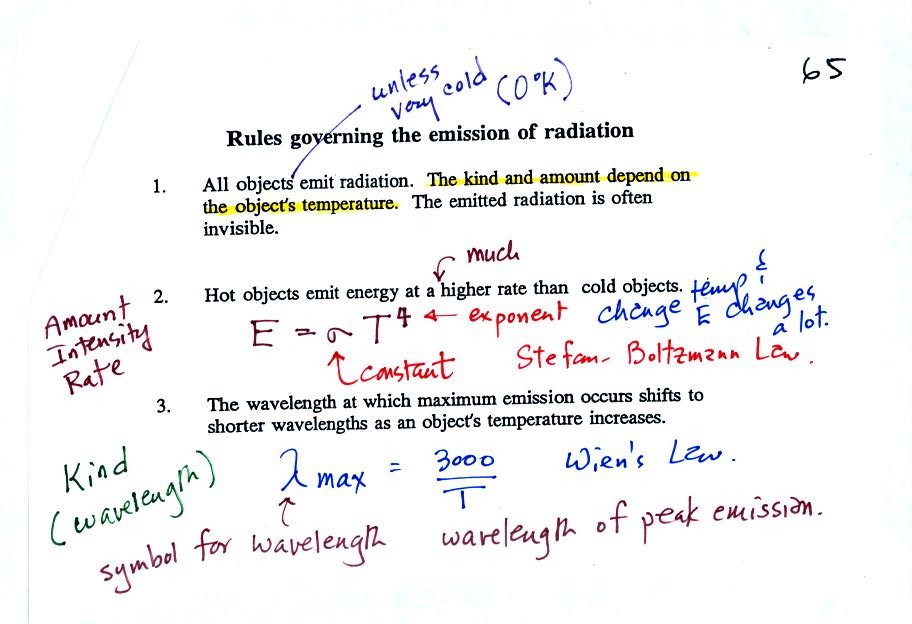
1.
Unless an object is very cold (0
K) it will emit EM
radiation. All the people, the furniture, the walls and the floor
in the classroom are emitting EM radiation. Often this radiation
will be invisible so that we can't see it and weak enough that we can't
feel it. Both the amount and kind (wavelength) of the emitted
radiation depend on the object's temperature.
2.
The second rule allows you to
determine the amount of EM radiation (radiant energy) an object will
emit. Don't worry about the units,
you can think of this as amount, or rate, or intensity.
Don't worry about σ either, it is just a
constant. The amount depends on temperature to
the fourth
power. If the temperature of an object doubles the amount of
energy emitted will increase by a factor of 2 to the 4th power
(that's 2 x 2 x 2 x 2 = 16). A hot object just doesn't emit a
little more energy than a
cold object it emits a lot more energy than a cold object. This
is illustrated in the following figure (which wasn't shown in class):
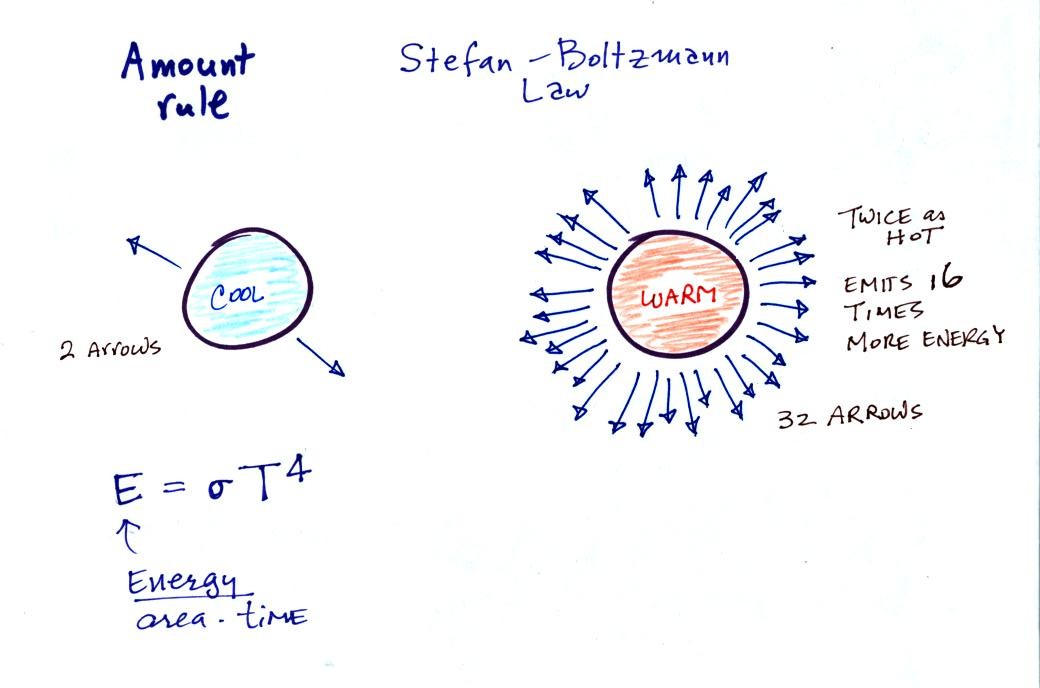
3.
The third rule tells you something
about the kind of radiation emitted
by an object. We will see that objects usually emit radiation at
many different wavelengths. There is one wavelength however at
which the object emits more energy than at any other wavelength.
This is called lambda max (lambda is the greek character used to
represent wavelength) and is called the wavelength of maximum
emission. The third rule allows
you to calculate "lambda max." This is illustrated below (also not shown in class):
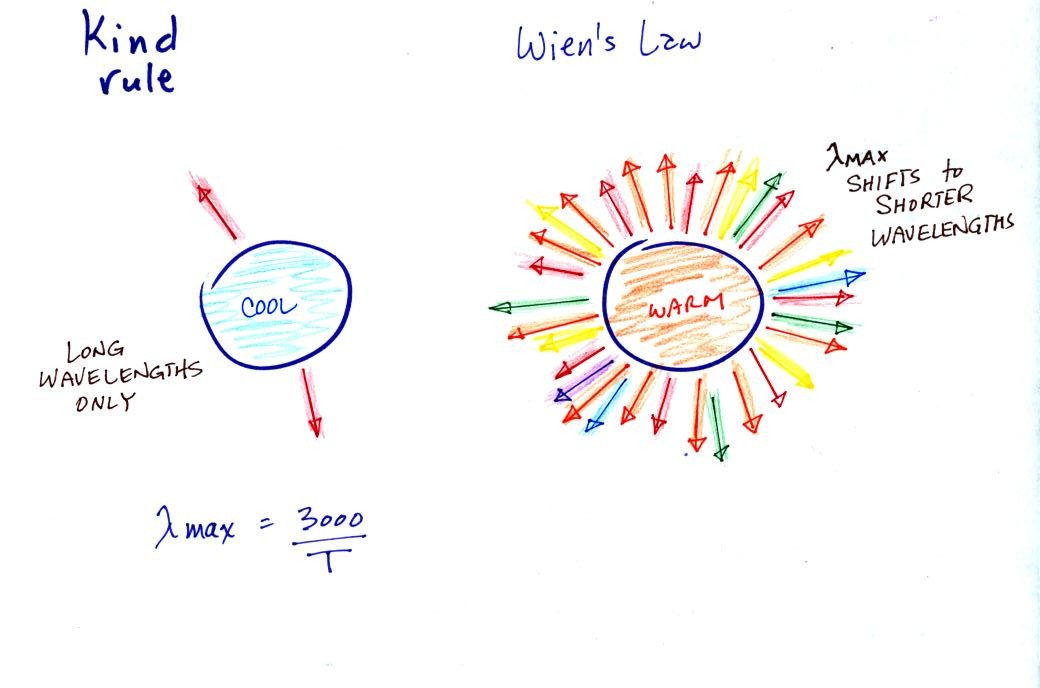
The graph below also helps to illustrate the
Stefan-Boltzmann
law and Wien's law, particularly the meaning of lambda max.
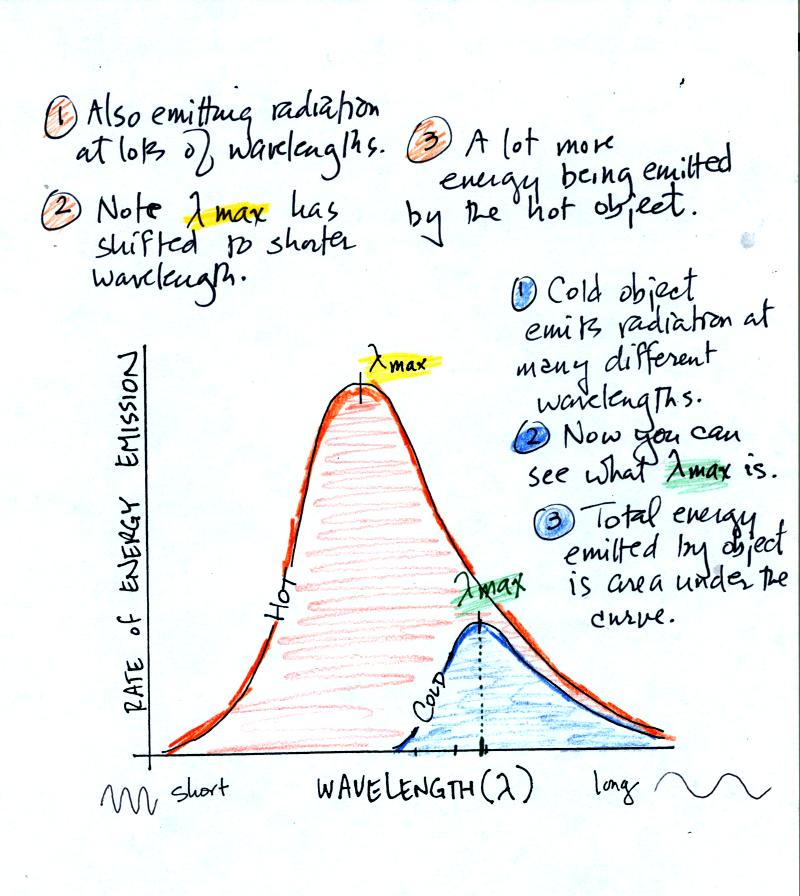
Notice first that both and warm and the cold objects emit
radiation
over a range of wavelengths. In some respects this is like quiz
grades. Not everyone in the room gets the same score; there's
usually a very wide range of scores. Objects do emit more of one
particular wavelength than any other wavelength. This is lambda
max.
The area under the warm object curve is much bigger than the area under
the cold object curve. The area under the curve is a measure of
the total radiant energy emitted by the object. This illustrates
the fact that the warmer object emits a lot more radiant energy than
the colder object.
Lambda max has shifted toward shorter wavelengths for the warmer
object. This is Wien's law in action. The warmer object is
emitting a lot of short wavelength radiation that the colder object
doesn't emit.
A bulb
connected
to a dimmer switch can be used to demonstrate the
rules above (see p. 66 in the photocopied Classnotes). We'll be
interested in and looking at the EM
radiation emitted by
the tungsten filament in the bulb.
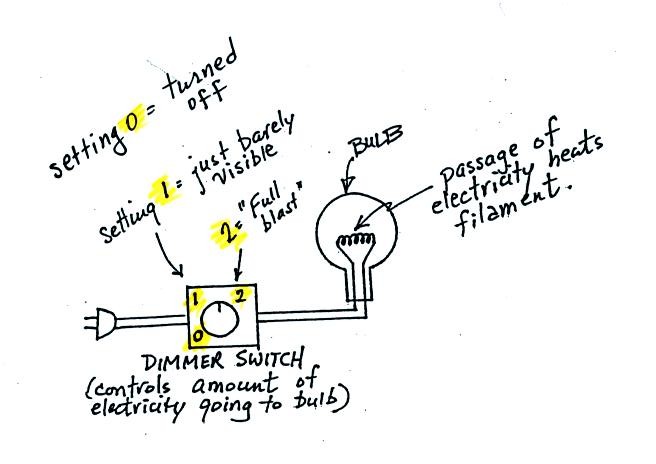
The bottom of p. 66 has been redrawn below for clarity:
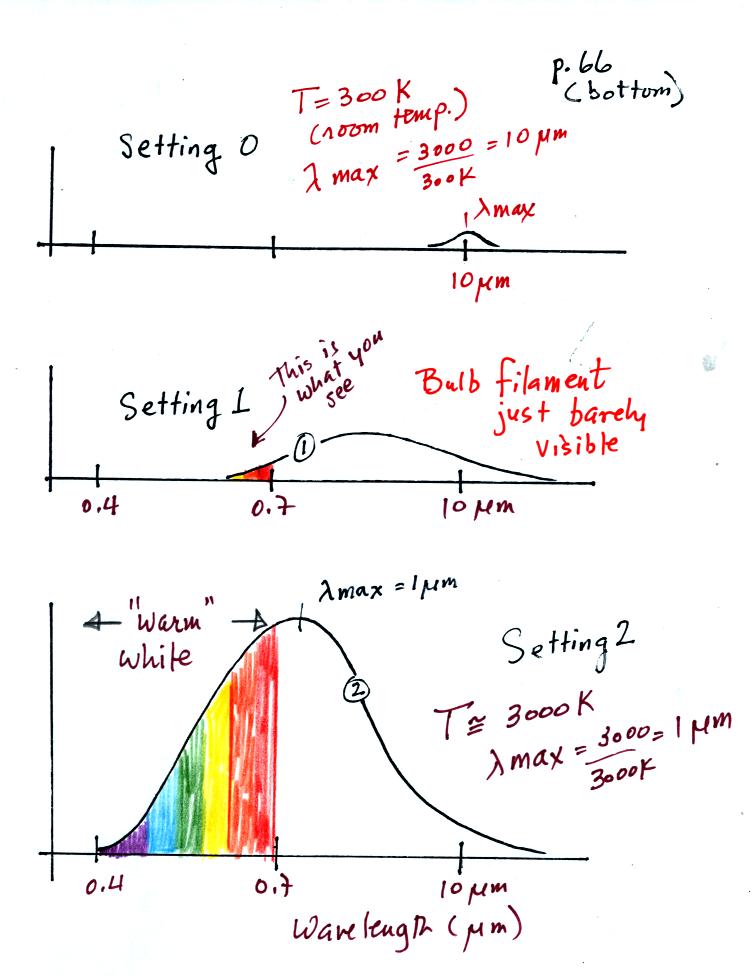
We start with the bulb turned off (Setting 0). The
filament will be at room temperature which we will assume is around 300
K (remember that is a reasonable and easy to remember value for the
average temperature of the earth's surface). The bulb will be
emitting radiation, it's shown on the top graph above. The
radiation is very weak so we
can't
feel it. It is also long wavelength far IR radiation so we
can't see it. The wavelength of peak emission is 10 micrometers.
Next we use the dimmer switch to just barely turn the bulb on (the
temperature of the filament is now about 900 K).
The bulb wasn't very bright at all and had an orange color. This
is curve 1, the middle figure. Note the far left end of the
emission curve has
moved left of the 0.7 micrometer mark - into the visible portion of the
spectrum. That is what you are able to see, the small
fraction of
the radiation emitted by the bulb that is visible light (but just
long wavelength red and orange light). Most of the radiation
emitted by the bulb is to the right of the 0.7 micrometer mark and is
invisible IR radiation (it is strong enough now that you could feel it
if you put your hand next to the bulb).
Finally we turn on the bulb completely (it was a 200 Watt bulb so it go
pretty bright). The filament temperature
is now about 3000K. The bulb is emitting a lot more visible
light, all the colors, though not all in equal amounts. The
mixture of the colors produces a warm
white light. It is warm because it is a mixture that contains a
lot more red, orange, and yellow than blue, green, and violet
light. It is interesting that most of the radiation emitted by
the bulb is still in the IR portion of the spectrum (lambda max is 1
micrometer). This is
invisible light. A tungsten bulb like this is not especially
efficient, at least not as a source of visible light.
You were able to use one of the diffraction gratings to view all the
colors that make up visible light.
When you looked at the bright white bulb filament through one of the
diffraction gratings the colors were smeared out to the right and left
as shown below:
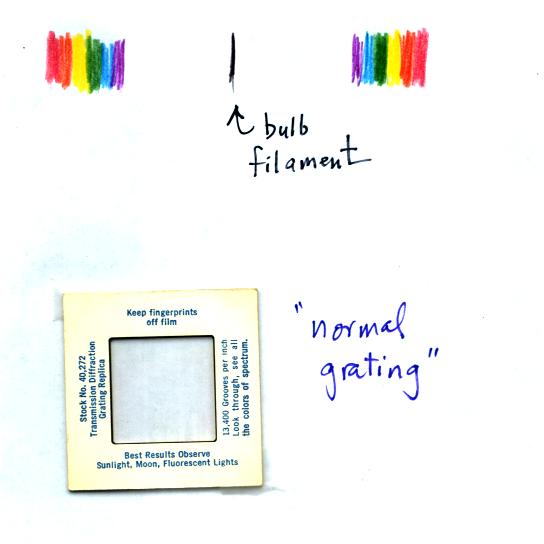
Some of the gratings behaved a little differently as shown below:

The sun
emits electromagnetic radiation. That shouldn't come as a surprise
since you can see it and feel it. The earth also emits
electromagnetic radiation. It is much weaker and invisible.
The kind and amount of EM radiation emitted by the earth and sun depend
on their respective temperatures.
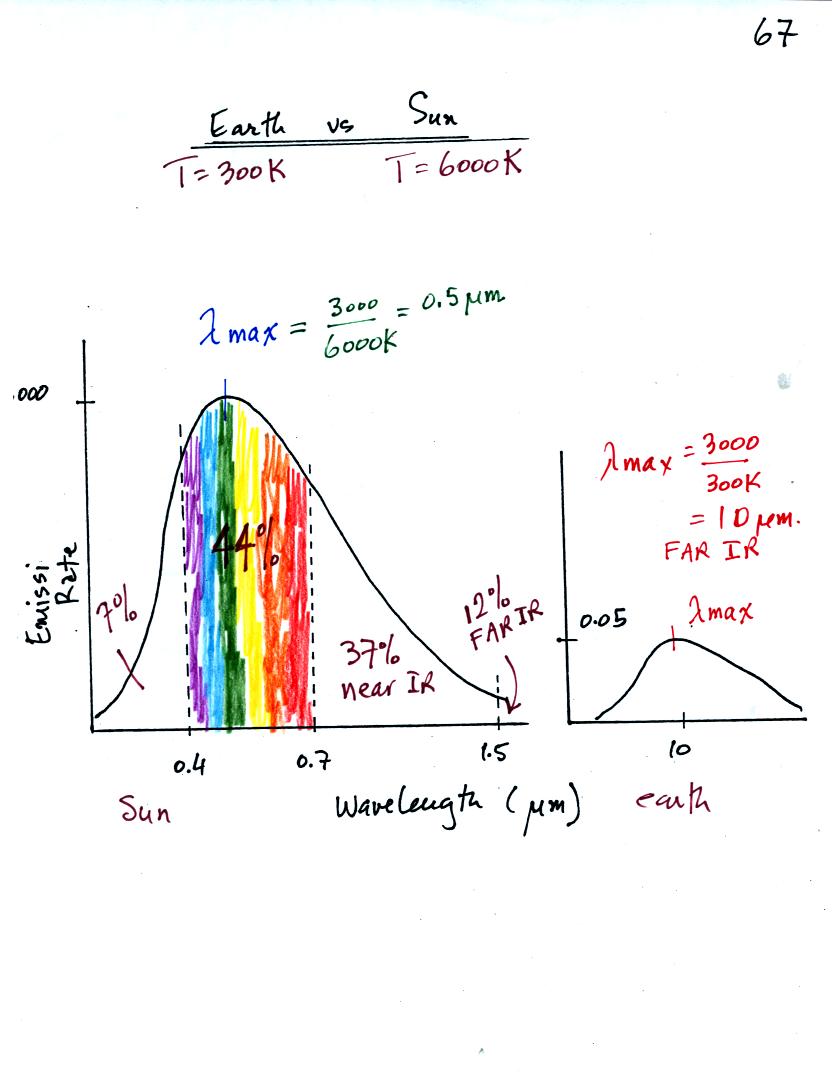
The curve on the left is for the sun. We first used Wien's
law and a temperature of 6000 K to calculate lambda max and got
0.5 micrometers. This is green light; the sun emits more green
light than any other kind of
light. The sun doesn't appear green because it is also emitting
lesser amounts of violet, blue, yellow, orange, and red - together this
mix of
colors appears white. 44% of the radiation emitted by the sun is
visible light, 49% is IR light (37% near IR + 12% far IR), and 7%
is ultraviolet light. More than half of the light emitted by the
sun is invisible.
100% of the light emitted by the earth (temperature = 300 K) is
invisible IR light. The
wavelength of peak emission for the earth is 10 micrometers.
Because the sun (surface of the
sun) is 20 times hotter than the earth a square foot of the sun's
surface emits energy at a rate that is 160,000 times higher than a
square foot on the
earth. Note
the vertical scale on the earth curve is different than on the sun
graph. If both the earth and sun were plotted with the same
vertical scale, the earth curve would be too small to be seen.
We saw
earlier that tungsten bulbs produce a lot of wasted
infrared light (wasted in terms of not lighting up a room). They
also
produce a warm white color. Energy efficient compact
fluorescent lamps (CFLs) are
designed to mimic the visible light output of a tungsten bulb without
producing a lot of wasted infrared light. CFLs come with
different color temperature ratings.
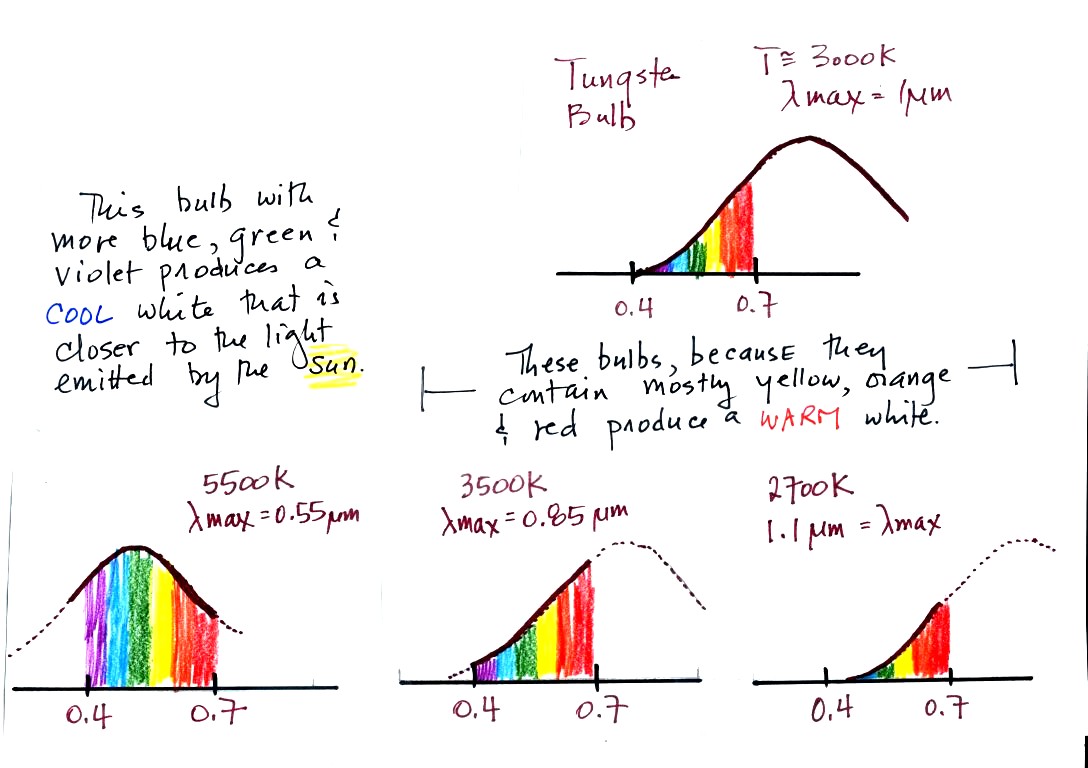
The bulbs with the hottest temperature rating (5500 K ) in the figure
above emits more purples, blues, and greens and produces a cooler,
bluish white. This is much closer to the light emitted by the
sun.
The tungsten bulb (3000 K) and the CFLs with temperature ratings of
3500 K and 2700 K produce a warmer white.
Three CFLs with the temperature ratings above were set up in class so
that you could see the difference between warm and cool white light.
You can see a clear difference between the cool white bulb on the left
in the figure below and the warm white light produced by a tungsten
bulb (2nd from the left) and 2 CFCs with low temperature ratings (3rd
and 4th from the left). This figure is from an article
on compact fluorescent lamps in Wikipedia.
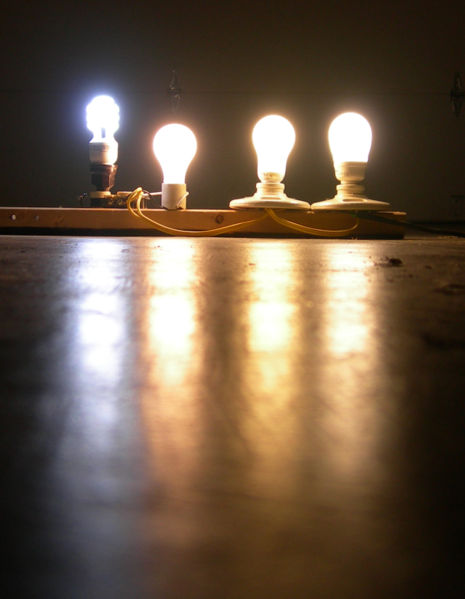












 EM radiation is created
when you cause a charge to move up and down.
If you move a charge up and down slowly (upper left in the
figure above) you would produce long wavelength radiation that would
propagate out to the right at the speed of light. If you move the
charge up and down more rapidly you produce short wavelength radiation
that propagates at the same speed.
EM radiation is created
when you cause a charge to move up and down.
If you move a charge up and down slowly (upper left in the
figure above) you would produce long wavelength radiation that would
propagate out to the right at the speed of light. If you move the
charge up and down more rapidly you produce short wavelength radiation
that propagates at the same speed.










